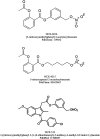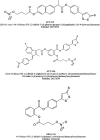Gaseous Mediators as a Key Molecular Targets for the Development of Gastrointestinal-Safe Anti-Inflammatory Pharmacology
- PMID: 33995080
- PMCID: PMC8116801
- DOI: 10.3389/fphar.2021.657457
Gaseous Mediators as a Key Molecular Targets for the Development of Gastrointestinal-Safe Anti-Inflammatory Pharmacology
Abstract
Non-steroidal anti-inflammatory drugs (NSAIDs) represent one of the most widely used classes of drugs and play a pivotal role in the therapy of numerous inflammatory diseases. However, the adverse effects of these drugs, especially when applied chronically, frequently affect gastrointestinal (GI) tract, resulting in ulceration and bleeding, which constitutes a significant limitation in clinical practice. On the other hand, it has been recently discovered that gaseous mediators nitric oxide (NO), hydrogen sulfide (H2S) and carbon monoxide (CO) contribute to many physiological processes in the GI tract, including the maintenance of GI mucosal barrier integrity. Therefore, based on the possible therapeutic properties of NO, H2S and CO, a novel NSAIDs with ability to release one or more of those gaseous messengers have been synthesized. Until now, both preclinical and clinical studies have shown promising effects with respect to the anti-inflammatory potency as well as GI-safety of these novel NSAIDs. This review provides an overview of the gaseous mediators-based NSAIDs along with their mechanisms of action, with special emphasis on possible implications for GI mucosal defense mechanisms.
Keywords: carbon monoxide; gastrointestinal safety; hydrogen sulfide; inflammation; nitric oxide; non-steroidal anti-inflammatory drugs.
Copyright © 2021 Danielak, Wallace, Brzozowski and Magierowski.
Conflict of interest statement
JW was employed by Antibe Therapeutics, Inc. The remaining authors declare that the research was conducted in the absence of any commercial or financial relationships that could be construed as a potential conflict of interest.
Figures






Similar articles
-
NSAID-induced gastrointestinal damage and the design of GI-sparing NSAIDs.Curr Opin Investig Drugs. 2008 Nov;9(11):1151-6. Curr Opin Investig Drugs. 2008. PMID: 18951293 Review.
-
[TRENDS IN DEVELOPMENT OF GI-SAFE ANTI-INFLAMMATORY DRUGS].Klin Med (Mosk). 2017;95(3):222-7. Klin Med (Mosk). 2017. PMID: 30303341 Review. Russian.
-
Gaseous mediators nitric oxide and hydrogen sulfide in the mechanism of gastrointestinal integrity, protection and ulcer healing.Molecules. 2015 May 19;20(5):9099-123. doi: 10.3390/molecules20059099. Molecules. 2015. PMID: 25996214 Free PMC article. Review.
-
Gaseous mediator-based anti-inflammatory drugs.Curr Opin Pharmacol. 2015 Dec;25:1-6. doi: 10.1016/j.coph.2015.08.005. Epub 2015 Aug 28. Curr Opin Pharmacol. 2015. PMID: 26319186 Review.
-
Gaseous Mediators in Gastrointestinal Mucosal Defense and Injury.Dig Dis Sci. 2017 Sep;62(9):2223-2230. doi: 10.1007/s10620-017-4681-0. Epub 2017 Jul 21. Dig Dis Sci. 2017. PMID: 28733867 Review.
Cited by
-
Listen to Your Gut: Key Concepts for Bioengineering Advanced Models of the Intestine.Adv Sci (Weinh). 2024 Feb;11(5):e2302165. doi: 10.1002/advs.202302165. Epub 2023 Nov 27. Adv Sci (Weinh). 2024. PMID: 38009508 Free PMC article. Review.
-
Hydrogen Sulfide-Releasing Indomethacin-Derivative (ATB-344) Prevents the Development of Oxidative Gastric Mucosal Injuries.Antioxidants (Basel). 2023 Aug 2;12(8):1545. doi: 10.3390/antiox12081545. Antioxidants (Basel). 2023. PMID: 37627540 Free PMC article.
-
Carbon Monoxide and Nitric Oxide as Examples of the Youngest Class of Transmitters.Int J Mol Sci. 2021 Jun 2;22(11):6029. doi: 10.3390/ijms22116029. Int J Mol Sci. 2021. PMID: 34199647 Free PMC article. Review.
-
Paneth cell-derived iNOS is required to maintain homeostasis in the intestinal stem cell niche.J Transl Med. 2023 Nov 25;21(1):852. doi: 10.1186/s12967-023-04744-w. J Transl Med. 2023. PMID: 38007452 Free PMC article.
References
-
- Ambrosini M. V., Mariucci G., Rambotti M. G., Tantucci M., Covarelli C., Angelis L. D., et al. (2005). Ultrastructural Investigations on Protective Effects of NCX 4016 (Nitroaspirin) on Macrovascular Endothelium in Diabetic Wistar Rats. J. Submicrosc Cytol. Pathol. 37 (2), 205–213. http://www.ncbi.nlm.nih.gov/pubmed/16335593. - PubMed
Publication types
LinkOut - more resources
Full Text Sources
Other Literature Sources

